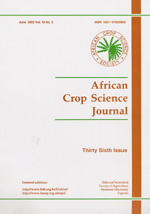
|
African Crop Science Journal
African Crop Science Society
ISSN: 1021-9730
EISSN: 1021-9730
Vol. 6, No. 3, 1998, pp. 215-225
|
 Bioline Code: cs98024
Bioline Code: cs98024
Full paper language: English
Document type: Research Article
Document available free of charge
|
|
|
African Crop Science Journal, Vol. 6, No. 3, 1998, pp. 215-225
| fr |
Wortmann, C.S.
Résumé
La productivité du haricot (Phaseolus vulgaris L.)est
bien contrainte par les déficits hydriques dans beaucoup d'aires de
production en Afrique de l'est et du sud. Le DSSAT3 drybean model a
été utilisé pour analyser les effets de
déficits hydriques sur le haricot en utilisant les coefficients
génétiques de quatre cultivars comprenant les types
précoces déterminés et les types nains
indeterminés à maturité intermédiaire et
tardive. Plus de 2300 simulations étaient performées en
utilisant les données météorologiques de 13 stations
écologiques. L'idiotype à maturité tardive a
donné le plus haut rendement dans les environnements moins
stressants mais son rendement a été le moins stable. Dans les
environnements plus stressants, les idiotypes à maturité
précoce ont eu le plus haut rendement et leur rendement a
été le plus stable dans tous les environnements. Le stress
était plus sévère et fréquent dans les derniers
stades de croissance et a affecté plus le rendement pendant la
période de formation et de remplissage des gousses; il était
moins durant le stade précoce de reproduction et moins plus durant
le stade végétatif. Les éléments d'une
stratégie possible pour améliorer l'adaptation aux
déficits hydriques sont analysés et l'information
spécifique pour l'application d'une telle stratégie est
donnée pour trois stations écologiques qui apparaissent
convenables comme sites primaires pour le criblage.
Mots Clés
Afrique, haricot, simulation de la croissance de culture, DSSAT3 Drybean Model, Déficit hydrique
|
| |
| en |
An adaptation breeding strategy for water deficit in bean developed with the application of the DSSAT3 drybean model
Wortmann, C.S.
Abstract
Bean (Phaseolus vulgaris L.) productivity is much constrained
by water deficits in many production areas in eastern and southern Africa.
The DSSAT 3 Drybean model was used to analyze the effects of water deficits
on bean using genetic coefficients of four cultivars including an early,
determinate type and early, intermediate and late maturity indeterminate
bush types. More than 2300 simulations were run using meteorological data
from 19 locations. The late maturing ideotype gave highest yield in less
stressful environments but its yield was the least stable. In more
stressful environments, early maturing ideotypes had highest mean yield and
their yield was most stable in all environments. Stress was most severe and
frequent in the later stages of growth; stress affected yield most during
pod formation and fill, less during the early reproductive stage and least
during the vegetative stage. Elements of a possible strategy for improving
adaptation to water deficits are discussed, and specific information for
the application of such a strategy is given for three locations which
appear suitable as primary screening sites.
Keywords
Africa, bean, crop growth simulation, DSSAT3 Drybean Model, water deficit
|
| |
© Copyright 1998 - African Crop Science Society
|
|
